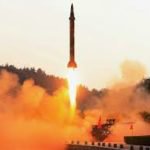Hwasong-18 Intercontinental Ballistic Missile
North Korea recently conducted a missile test, unveiling its latest weapon, the Hwasong-18. This intercontinental ballistic missile (ICBM) holds significance as it is the first North Korean missile to utilize solid propellants.
Understanding ICBMs
ICBMs are long-range ballistic missiles with the capability to carry nuclear warheads. Possessing a range of over 5,500 km, they are designed for intercontinental missions. Eight countries, including North Korea, Russia, the United States, France, the United Kingdom, China, India, and Israel, are documented to possess land-based ICBMs.
North Korea’s Motivation
The latest ICBM test by North Korea aimed to strengthen its self-defense capabilities and deter potential military threats. The country’s state media emphasized the need to safeguard regional peace and defend against hostile forces. This test is seen as a strategic move to solidify North Korea’s position in the face of growing tensions.
Test Flight and Impact
The Hwasong-18 missile’s test flight lasted a remarkable 74 minutes, making it the longest-ever recorded for a North Korean missile test. It landed approximately 250 km west of Okushiri island in northern Japan. This trajectory heightened concerns and led to emergency national security council meetings between South Korea and Japan, emphasizing the need for closer cooperation with the United States.
The Goal of Denuclearization
South Korea, Japan, and the United States share a joint goal of achieving complete denuclearization on the Korean Peninsula. The recent missile test by North Korea underscores the urgency of addressing the escalating tensions and finding diplomatic solutions to mitigate risks and maintain regional stability.
Month: Current Affairs - July, 2023
Category: International / World Current Affairs


